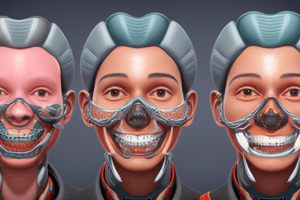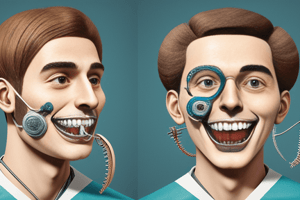Podcast
Questions and Answers
What is primarily involved in the remodelling of bone during orthodontic tooth movement?
What is primarily involved in the remodelling of bone during orthodontic tooth movement?
- Decay of periodontal tissue
- Apposition and resorption of bone (correct)
- Increased tooth sensitivity
- Calcification of enamel
What stimulates the remodelling of bone in response to orthodontic forces?
What stimulates the remodelling of bone in response to orthodontic forces?
- Physical stress on the enamel
- Changes in blood flow to the periodontal ligament (correct)
- Growth of new dental tissue
- Increase in systemic hormones
What effect is associated with changing the shape of a crystalline material?
What effect is associated with changing the shape of a crystalline material?
- Mechanical strength increase
- Thermal conductivity
- Electrical current flow (correct)
- Chemical reactivity enhancement
What roles do rhythmic electric pulses play in bone during periods of function?
What roles do rhythmic electric pulses play in bone during periods of function?
How does fluid behave under heavy biting pressure in the periodontal ligament?
How does fluid behave under heavy biting pressure in the periodontal ligament?
Flashcards are hidden until you start studying
Study Notes
Prolonged Tooth Pressure Movement
- Tooth movement involves the remodelling of the tooth socket, crucial for orthodontic treatment.
- Bone remodelling occurs around the periodontal ligament, entailing both apposition (building) and resorption (loss) of bone.
- The periodontal ligament undergoes reorganisation during tooth movement.
Stimuli for Bone Remodelling
- Changes in blood flow to the periodontal ligament (PDL) serve as a key stimulus for bone remodelling.
- The piezo-electric effect, potentially tied to biological electricity, may also play a role in this process.
The Piezo-Electric Effect
- The piezo-electric effect refers to the generation of an electrical current when crystalline materials, such as bone, change shape under stress.
- This effect is significant in skeletal tissues, potentially influencing bone remodelling and health.
Piezo-Electricity in Bone
- Sources of piezo-electricity in bone include bone minerals and collagen.
- Mechanical activities like chewing and walking generate rhythmic electric pulses that help maintain bone mineralisation.
Time Course of Events Under Heavy Biting Pressure
- Initial response to heavy biting pressure occurs within milliseconds, characterized by the incompressibility of fluid in the periodontal ligament.
- Over seconds, fluid leaks out of the periodontal ligament, facilitating movement and remodelling processes.
Studying That Suits You
Use AI to generate personalized quizzes and flashcards to suit your learning preferences.




